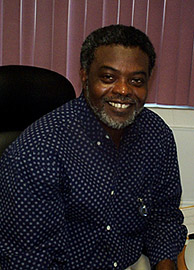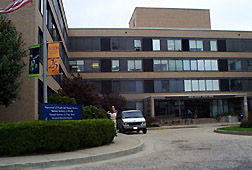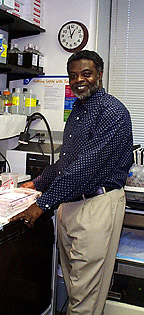
| T H E N I H C A T A L Y S T | N O V E M B E R – D E C E M B E R 2000 |
|
|
|
Translational ResearchJEAN LUD CADET:A BRIDGE AT NIDA |
by Fran Pollner |
 |
|
Jean
Lud Cadet
|
Jean Lud Cadet is equally at home upstairs and downstairs in the building that houses the NIDA intramural research program at the Johns Hopkins University Bayview campus in Baltimore.
On the third floor, Cadet runs the four labs that make up the Molecular Neuropsychiatry Unit, of which he is chief; and on the first floor, he directs NIDA’s clinical research program, overseeing the inpatient research unit, the outpatient research program, an adolescent clinic that focuses on smoking cessation, and the 70 currently active clinical protocols—all of which are conducted on-site.
Upstairs, researchers are charting—and figuring out ways to prevent—the neurodegenerative effects of illicit drugs in the brains of mice. Downstairs, they are documenting cognitive and hemodynamic deficits induced by these drugs in the brains of long-term human users—and the persistence of these effects, thus far, despite up to one month’s abstinence.
The paths between the first and third floors are well traveled, and when Cadet’s working in one location, he’s never far from the other, either physically or mentally. The hope is that the cellular and molecular mechanisms of toxicity unraveled in the lab will be brought to bear on the prevention and treatment programs in the clinic.
When he arrived at NIDA, in 1992, Cadet had an agenda: to identify the long-term neurological effects of drug abuse. The literature on that subject, he says, was sparse. It’s less sparse today.
Cadet and his colleagues have published extensively on the neurodegenerative effects of amphetamines and MDMA (Ecstasy), drugs of choice among adolescents today because "they’re cheap, accessible, and can be made very easily by any good chemist."
In cell culture and with transgenic mice that overexpress superoxide dismutase (SOD)—an enzyme that breaks down superoxide radicals and is abnormal in such conditions as amyotrophic lateral sclerosis—the team has demonstrated that the toxicity associated with methamphetamine and MDMA involves the production of superoxide radicals and can be offset by SOD. The transgenic mice are largely protected against the brain cell death (in the cortex, striatum, and hippocampus) that typically accompanies drug exposure in other mice.
Although SOD is too big a compound to gain easy access to the brain, smaller SOD mimics have shown some promise in experimental stroke models. Notwithstanding that the usefulness of an antioxidant strategy in humans has yet to be proved, Ecstasy makers and users—who apparently read the relevant scientific literature—have been observed at parties to combine the drug with an antioxidant vitamin cocktail.
 |
|
Two-thirds
of the U-shaped, four-story building that houses the NIDA intramural research
program in Baltimore
|
Biochemical changes in the brain consistent with cell death in humans have been observed in long-term users, Cadet notes, and could account for the cognitive impairment his team has documented in clinical studies designed to determine whether abstinence reverses drug-related cognitive deficits. Thus far, little change has been seen after a month of abstinence in studies involving heavy users of cocaine and alcohol; clinical studies involving amphetamine and Ecstasy users are anticipated next.
Longer-term studies are needed but are problematic, Cadet observes, because it is difficult, if not impossible, either to keep study volunteers confined for longer than a month or to ensure abstinence among a nonconfined population. One of the salient findings in the cognitive studies is that the constellation of deficits varies with the drug of abuse. Although all drugs exert their addictive effects along the dopamine pathway, their cognitive effects are played out in different regions of the brain—a fact that should serve as a guide to tailor treatment programs, Cadet says. "Everyone who comes in for treatment needs to be evaluated neurologically and neuropsychologically so that their therapeutic program can be planned around their particular impairments. Someone with attention deficits, for instance, might need a focusing medication in order to process the information offered in the program."
The fact that cocaine indeed causes cognitive deficits is only now beginning to be appreciated and is still not common knowledge. "It’s very new information. Our study (1) is one of the few to document clearly that this is the case," Cadet notes, although, he adds, people who have worked in the field with long-term cocaine abusers have suspected as much for a while now.
In another study undertaken to establish a physical basis for the increased risk of stroke among cocaine users, Cadet and colleagues measured cerebral blood flow using transcranial Doppler (TCD)—a "classical neurological approach." The brain vasculature and increased resistance to blood flow they found in their study population—chronic users in their 30s–resembled that reported for people in their 60s and 70s and for patients with multi-infarct dementia. As in the study of cognitive deficits, no changes were seen in the study cohort after one month of abstinence (2). "I think the blood flow abnormality is also related to the cognition deficits we’re seeing," Cadet adds, suggesting that therapies aimed at the one might also benefit the other.
Using cDNA arrays, Cadet
and his team also hope to identify genes that are affected by chronic drug use,
the better to get to precise mechanisms of toxicity and devise treatment strategies
specific to each of the drugs of abuse. The brain is far too complex, he says,
to imagine that one pathway would cover all bases. ![]()
References:
(1) K.I. Bolla, F.R. Funderburk, and J.L. Cadet. "Differential effects of cocaine and cocaine + alcohol on neurocognitive performance." Neurology 54:2285–2292 (2000).
(2) R.I. Herning, D.E. King, W.E. Better, and J.L. Cadet. "Neurovascular deficits in cocaine abusers." Neuropsychopharmacology 21:110–118 (1999).
 |
 |
Back to Back: Jean Lud Cadet wears two seamless hats—all the time—in his dual role as a basic science section chief (molecular neuropsychiatry) and clinical director of the NIDA IRP. His introduction to NIH and with it the realization that he wanted to spend his life in research came when he was a fourth-year medical student at New York’s Columbia University College of Physicians and Surgeons and had a three-month rotation at NIMH. He got his M.D. degree in 1979, undertook two residency programs–one in psychiatry and one in neurology–and then returned to NIH in 1984 as an NIMH medical staff fellow and ward chief at St. Elizabeth’s Hospital in Washington. He then taught at Columbia before rejoining NIH in 1992—this time at NIDA as chief of the neuropsychiatry and neurotoxicology unit. He became acting chief of the molecular neuropsychiatry section the following year and then chief when he was tenured a year later. He assumed the acting clinical directorship in 1994 and took on that permanent role in 1997. |